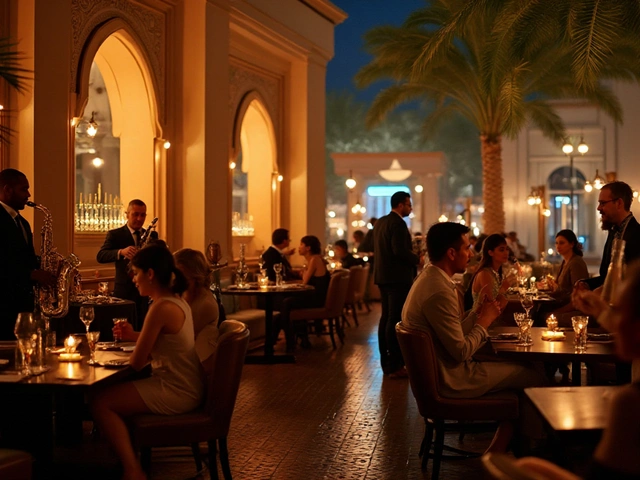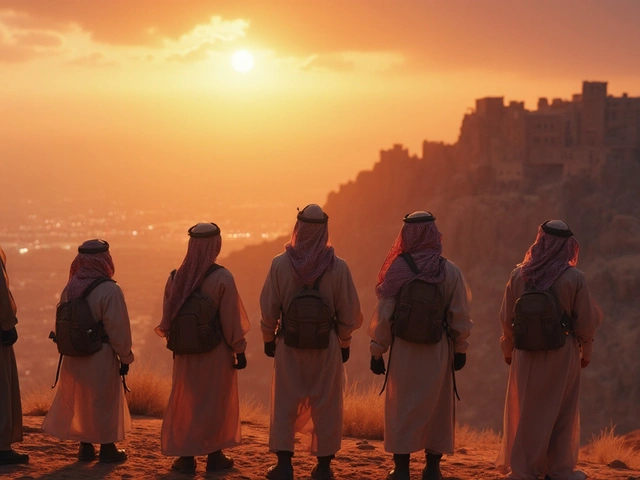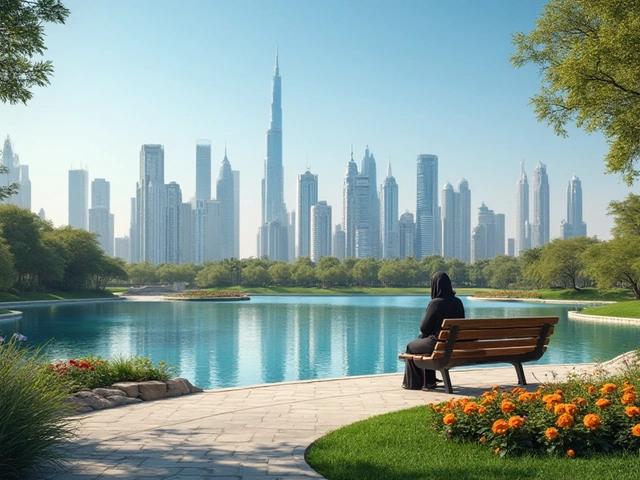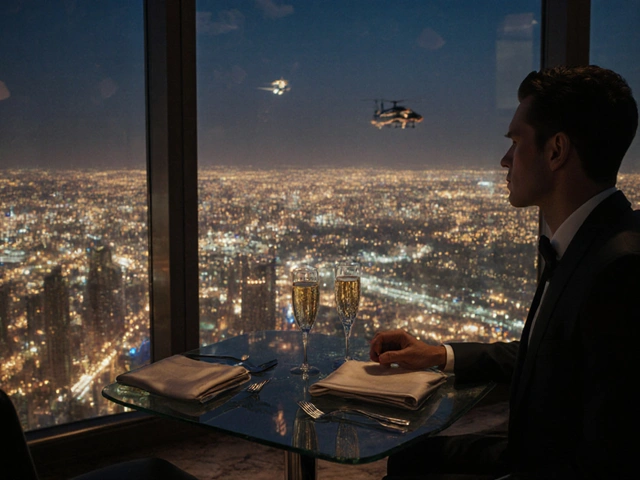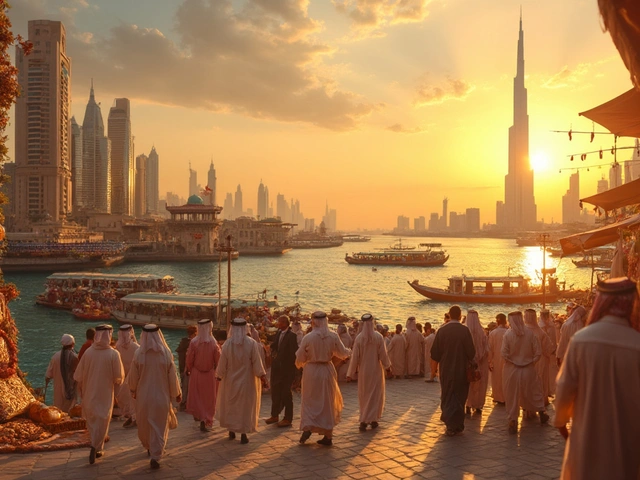Picture this: you're staring up at a gold-plated rectangle stretching 150 meters into the sky—one foot rooted in the past, the other in the future. Nowhere but Dubai could you stand inside a picture frame and witness, quite literally, the city's bold journey from humble trading port to glimmering megacity. The Dubai Frame isn’t just an attraction; it’s a story in steel, glass, and history, woven into the heart of Zabeel Park. Some say it’s the UAE’s answer to the Eiffel Tower—a symbol meant to be iconic, not just beautiful. Step in, and you’re not just snapping another skyline shot; you’re stepping into Dubai’s time machine.
A Structure Caught Between Past and Future
The Dubai Frame’s design blends old Dubai and new Dubai with the world’s largest frame as your literal window. Designed by Fernando Donis, the same architect behind Dubai’s Porsche Design Towers and Dubai’s Renaissance Tower, it’s shaped purposely to act as a picture frame, just on a monumental scale. The actual structure links the older neighborhoods of Deira and Karama to the shimmering skyscrapers of Sheikh Zayed Road, so every visit feels like a foot in two worlds.
The gold cladding isn’t just for show—it uses a complicated process called "stainless steel cladding with titanium nitride coating" which makes it shine whether you’re visiting at sunrise or when Dubai’s famous orange dusk blankets the city. Take a look up close, and you’ll spot ringed patterns inspired by Dubai Expo 2020’s logo—a subtle local nod. This design detail connects the Frame to the city’s global vision, linking to how Dubai positions itself for residents and visitors alike: always looking forward, never forgetting its roots.
The elevator ride alone is its own show. Within 75 seconds, you glide up to a 93-meter-long glass bridge that gives you 360-degree views of both old Souks and the city’s modern icons. On one side: the low-rise, sand-hued sprawl of Deira and the bustling alleys of Al Fahidi Historical Neighborhood. On the other: the Burj Khalifa, Emirates Towers, and all the steel-and-glass giants glancing at the Gulf. This isn’t just sightseeing—the Frame literally lines up these two worlds, drawing a bold gold line between then and now.
Past, Present, Future: Inside the Dubai Frame Experience
Step inside the base, and you’re greeted by the immersive Dubai Past Gallery. Gone are dusty museum dioramas—here, UAE heritage comes alive through 3D projections, interactive screens, and even the subtle scent of frankincense and spice, reminders of Dubai Creek’s early days trading pearling. Don’t rush through: for locals, you’ll spot family names, images of bygone souks, and the boats (abra) that once defined daily life. For expats, it’s a crash course in what made the city beloved long before high-rises and brunches at Jumeirah.
As you ride the elevator, the transformation continues. The second floor—known as the "Present"—is a panoramic platform with a glass-floored walkway. Most walk gingerly at first, convinced that stepping out will send them tumbling toward those palm-lined walkways below. But Dubai wouldn’t let you fall; in fact, the 25-square-meter glazed panels are stronger than reinforced concrete, even holding crowds during New Year’s Eve celebrations. Watch the city’s pulse from above as taxis crawl along the roads like yellow ants, the Metro streaks silver, and planes trace ribbons toward DXB airport’s arrival boards.
The final stop is the Future Dubai Gallery. Here, VR shows, holograms, and interactive exhibits let you build Dubai’s next skyline or imagine life by 2050—when, if you believe local optimism, flying cars and robot cops may be as regular as camel carvings used to be in heritage villages. For families, this section is a huge hit; kids leave with ideas far beyond the Burj Khalifa’s shadow. Locals, too, find pride in these aspirational displays, as many Emiratis see the Frame as a reminder of Dubai’s drive to dream ever bigger. Many teachers use the Frame for school field trips, sparking ideas about engineering and innovation for the next generation.
Insider Tips and Tricks for Exploring Dubai Frame
Planning a visit to the Dubai Frame in summer? Book your tickets online at the official Dubai Frame site, as lines often swell in the afternoon. Morning hours offer the clearest skies—and cooler breezes. The Frame opens at 9am daily, but try to arrive by 8:40am, so you’re first in line. For Emirati and expat families, entry is discounted for children under 12 and kids under 3 get in free. UAE residents carrying the Fazaa card can unlock further discounts at the ticketing desk, and Dubai’s NOL card holders occasionally catch special holiday offers—especially around Eid and National Day.
Want that perfect photo with no crowds photobombing your skyline shot? Head to the north corner of Zabeel Park. Here, photographers from Gulf News and Khaleej Times have snapped Dubai Frame shots that end up on magazine covers. Evenings are magical, but count on longer lines, as Dubai’s golden hour draws all Instagrammers, TikTokers, and wedding photography crews. Ramadan nights bring peaceful silence, and the Frame glows gold against velvet skies.
Security is tight but friendly. No food, large backpacks, or professional camera gear unless you’ve booked a permit (pro tip: leave the tripod, but carry a smartphone with ultra-wide angle mode). There are plenty of clean washrooms and prayer rooms—always a must for visitors with families or on a quick cultural trip during Friday prayers. Grabbing a quick snack after your visit? Dubai Frame Café and the little Pop Up Corn kiosks outside sell saffron-infused lattes, Karak tea, and sweet Emirati luqaimat dumplings instead of the universal Starbucks (for once). The Frame is walkable from Al Jafiliya Metro Station if you want to avoid parking queues, but for families with strollers or those carrying shopping bags from Dubai Mall, Zabeel Park’s taxi rank is a quick hop away.
What Makes Dubai Frame Unique in Dubai’s Attractions?
Dubai boasts bucket-list attractions like Burj Khalifa, The Dubai Mall, and the Palm Jumeirah—but the Frame’s unique selling point is its role as a cultural bridge. While the Burj shows tomorrow, and the souks echo yesterday, the Frame literally joins them. In the past year, Dubai Frame welcomed over 1.5 million visitors, according to Dubai Municipality figures, with more than a third coming from within the UAE. That’s rare: most Dubai icons skew toward tourists, but the Frame draws Dubai’s own communities back for repeat visits. School groups, families from Sharjah, and business travelers on a lunch break all turn up to see “both sides” of their Dubai.
Culturally, the Frame’s exhibits highlight the stories of the city’s growth—how Dubai evolved from a pearl-diving backwater into a global shipping and tech power. Check out the art section celebrating Emirati and Khaleeji artists, with sketchbooks showing the city’s transformation decade by decade. Local historians sometimes host Q&A nights about life in Dubai before oil—a topic rarely covered in tourist guides. And the Frame’s events calendar is packed: National Day light shows, Diwali lantern installations, and even Ramadan storytelling sessions in Arabic and English. Visitors during the holy month can listen to Emirati storytellers sharing tales of the Bedouin and the history of Dubai’s hospitality culture.
Shopping lovers get an unexpected bonus—during Dubai Shopping Festival (typically in January), the Frame doubles as an event venue, with pop-up art booths and traditional Al Ayala dance performances near the entrance. Foodies love when Emirati chefs serve heritage dishes like Machboos and Legaimat at tasting stalls just outside. For residents, it feels less touristy and more like a community hub. Plus, you’re minutes away from Zabeel Park’s flea market, which fills up on Saturdays with locals selling vintage abayas, Pakistani jewelry, and Persian carpets.
Key Stats, Practical Info, and Visitor Data
Wondering how Dubai Frame stacks up against the city’s other big-ticket attractions? Here’s a breakdown you won’t find in every travel guide:
| Dubai Frame Facts & Figures | Details |
|---|---|
| Height | 150 meters |
| Width | 93 meters |
| Opened | January 2018 |
| Annual Visitors (2024) | 1.5 Million |
| Average Visit Duration | 1.5-2 Hours |
| Elevator Speed | 75 seconds (bottom to top) |
| Frame Cladding | Titanium Nitride Coated |
| Bridges Views | Old Dubai, New Dubai |
Unlike the Burj Khalifa, you don’t need to pre-book months in advance—though during peak holidays (think December, Eid-Al-Fitr, or UAE National Day), tickets do sell out fast. Prices are friendlier too: as of July 2025, adult tickets cost around 50 AED, with children’s passes just under half that. Special rates apply for senior citizens and people of determination (with accompanying helper free of charge). During Dubai Summer Surprises festival, locals get bundled deals, including free Zabeel Park entry and Frame tickets, via the Dubai Now app.
Most visitors spend 90-120 minutes on-site. The elevator can get busy midday, especially when tour groups arrive from cruise ships. If you’re looking for space, plan your visit for a weekday, mid-morning, when business crowds thin out. If you’re a resident or expat, consider the "VIP Experience" tour—available by request—where local guides share deeper insights, from architectural secrets to personal stories about growing up in Dubai’s shadow.
Yes, it’s wheelchair- and stroller-friendly throughout, with lifts, ramps, and wide corridors. For the best view, aim for a clear day—Dubai’s rarely cloudy, but during Shamal sandstorms, the city can appear subtly muted (almost nostalgic, really). Ramadan evenings and public holidays draw Dubai’s diverse populations together, turning the Frame into a mini-United Nations of traditions and costumes. If you’re curious about other languages, the Frame’s info panels come in Arabic, English, Russian, and Mandarin, perfect for Dubai’s international crowd.
Dubai Frame’s Meaning for the Local Community
For a city that never stops reinventing itself, Dubai Frame is more than a tourist must-see. It’s a place where Dubai’s millions of residents remember their shared journey and imagine what comes next. Local families snap yearly selfies here—some at the exact same corner, tracing how the skyline expands each time. Expats new to Dubai get an instant crash course in the city’s whirlwind journey; seasoned residents reflect on neighborhoods transformed beyond recognition. Business professionals sometimes bring clients here to spark up big-picture thinking—standing above the city, you can’t help but feel Dubai’s relentless energy and optimism.
The Frame has also become a symbol in pop culture, featuring in local films, viral TikToks, and even the backdrop for influencer marriage proposals (yes, really—floor-to-ceiling gold is hard to beat for romantic drama). On social media, the hashtag #DubaiFrame trends every week with photos shot from dizzying new angles. Event planners love its vibe: you’ll spot corporate team-building scavenger hunts, yoga classes on the green lawns outside, and charity fun runs circling the grounds.
Even for skeptics used to Dubai’s “go big or go home” attractions, the Frame’s story-driven approach hits different. Where else can you see a whole city’s past and future overlayed in 360 degrees? In a city built for bold moves, the Dubai Frame stands out for mixing vision with heart—a place where anyone in Dubai can pause, look back, and then step forward, one sky-high frame at a time.

